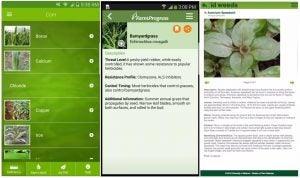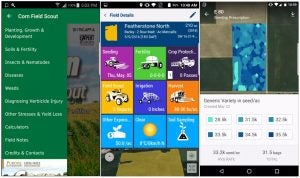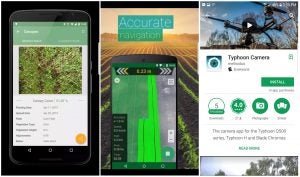The latest top-of-the-line phones come with octa-core processors, 4GB of RAM, and up to 128GB of digital storage space — specs that were impressive for a desktop computer not long ago. Our “pocket computers” also contain useful tools like GPS, high-resolution cameras, and mobile data connections. However, the usefulness of mobile technology in our daily lives depends heavily on which applications are available.
Read on to discover how apps can increase productivity, simplify your life, and possibly even change the way we farm in the near future.

Must-haves
For me, one of the most practical ways to use my phone in the field is to take pictures of deficiency symptoms and pests, mark their location, and attempt to identify the issue. Ag PhD Deficiencies has images of the most common nutrient deficiencies sorted by crop in a simple interface. Ag Weed ID is easy to use and helps identify weeds by season and geographic location. ID Weeds has the most comprehensive weed list and search parameters, but the user interface was glitchy in my experience. I have yet to find a good app for disease or insect identification across multiple crops in the U.S. If you want to identify these pests in the field, they are best covered in crop-specific apps (see next section).

New or updated for 2017
Corn Field Scout and Soybean Field Scout both offer a comprehensive suite of diagnostic tools, calculators, and almost anything else you could want regarding each crop. They cost $5.99 each, but there is a free “Preview” version to test both apps before buying. (Quick tip: Refunds are sometimes issued by contacting the developer of paid apps if you try it and immediately decide you don’t like it!)
Trimble Ag Mobile helps manage crop scouting, bins, contracts, field applications, and much more. The ability to update and view important farm information anytime and anywhere can lead to improved management decisions and organization.
FarmLogs raises the bar for record keeping and information delivery on a per-field basis. Input field boundaries and get rainfall, growing degree day, soil data, and more for free. Options like in-season satellite imagery and crop health alerts are also available for a fee.

Looking ahead
Canopeo is a tool used to estimate percent canopy coverage of green vegetation. Measuring canopy coverage can be useful to gauge wheat vigor from fall to spring, compare emergence across a field, or determine whether different management strategies resulted in variable early-season growth. This app also marks an important direction that the sensor market could take — one in which we use a free app on equipment we already have, or can buy inexpensively.
Field Navigator – Parallel attempts to turn your phone into a precision farming tool to help you drive perfectly straight lines. This app, and others available, can also use a Bluetooth GPS receiver to increase accuracy. Farmers interested in precision guidance in their machinery may find this method a low-cost way to test the waters. Perhaps more importantly, apps like these indicate that in the future we may be able to simply dock our phone or tablet and use it as an all-in-one controller for autosteer, data recording, etc.
Typhoon Camera is one of multiple apps that enable you to view live video from a camera mounted on a UAV. Combining this technology with that of an app like PrecisionFlight for DJI could eventually result in a real-time NDVI, NIR, or similar actionable map of your field.
The release of the apps discussed above further conveys that seemingly every technology is moving towards being phone or tablet oriented. Companies in computers, auto, healthcare, and entertainment already recognize this, and agricultural companies will do the same given that we as consumers show the interest and desire for applications built for the mobile technology we already own. Thanks for reading, and feel free to share your thoughts on the most useful current apps or your idea for what the future of mobile technology in agriculture should look like!



